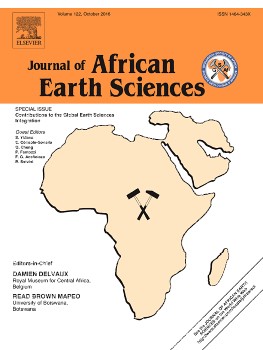
Petrography, mineralogy, geochemistry and genesis of the Balaya bauxite deposits
The Balaya bauxite plateau is located in the Kindia bauxite province; where the bauxite ores are found above Ordovician and Silurian formations in the southern part of the Guinean Paleozoic Bove Basin, West African Craton. In this study, petrographical, mineralogical and geochemical investigations were carried out on the different type of bauxites (sedimentary and lateritic) of this plateau. Mineralogical analysis and petrological study revealed that the mineralogy is almost identical in both bauxite types of the Balaya plateau. Gibbsite (ave. 83.90%), goethite and aluminous goethite are the major mineral components; anatase, rutile, diaspore and kaolinite are minor minerals, with zircon and clastic quartz as accessory minerals in the bauxites. Whole rock and trace elementsanalysis show that the main components of the Balaya bauxites ore are Al2O3 (49.70–61.00 wt%), SiO2 (0.30–5.00 wt%), Fe2O3 (1.60–19.00 wt%), and TiO2 (1.71–3.70 wt%). Trace elements investigation indicates that HFSEs, Ti, Cr, Ga, Sn, HREE were immobile and specifically enriched; whereas alkalis and alkaline earth metals were depleted, in bauxites during lateritization. Geochemical paths of dismantlement, immobile element ratios (Zr vs Hf, Nb vs Ta and Yb vs Lu; and Cr/Ni) and REE patterns of the bauxites indicate that they were all originated from the destruction of the kaolinite by a deep of lateritization, through an indirect bauxitization of the Silurian argillites and siltstones of the Télimélé Suite. Thus, Balaya sedimentary bauxites were further formed by redepositionfrom these lateritic bauxites, by different mechanical transportation. Pearson correlation and mass change calculations revealed that Ti-bearing and Fe-bearing minerals are the carrier for HREE, HFSE, Sn, U, Ga, W and Y; and Mo, Cu, Pb, As, Sb and Bi respectively. P-bearing minerals and kaolinites could have played signifiquent roles in LREE concentration, but the possible presence of authigenic minerals such as strontianite, celestite or florencite bearing the LREE are expected.
source: https://www.sciencedirect.com